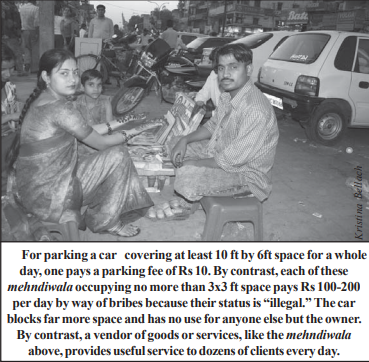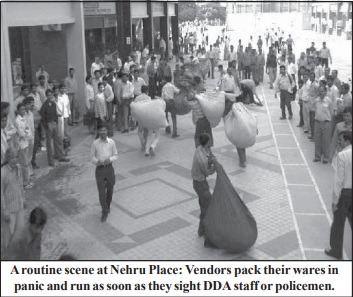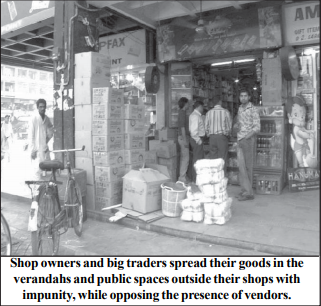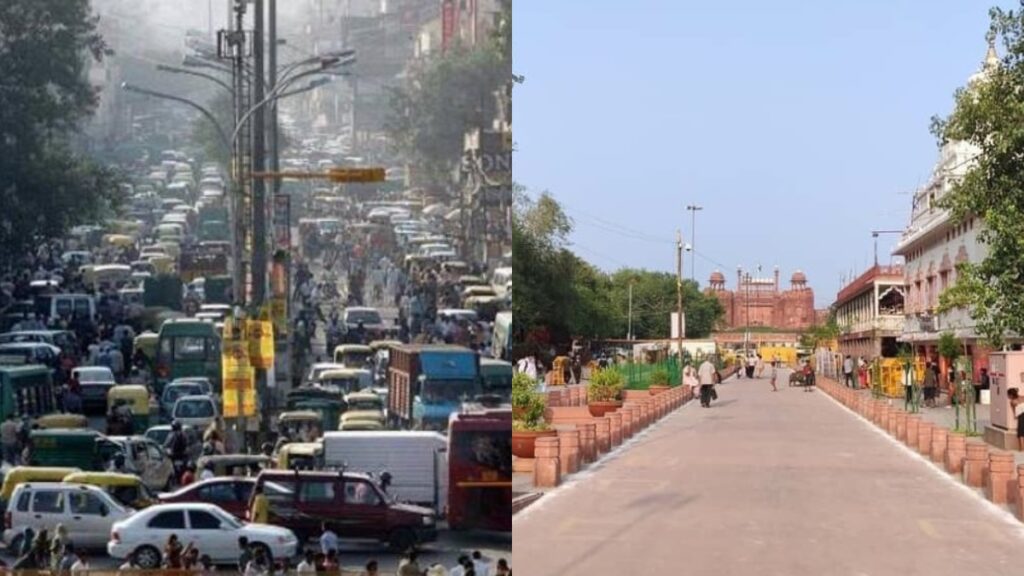This was first published in the print edition of Manushi Journal, Issue no. 153 of 2006.
In response to a petition filed by the Chandni Chowk Vyapar Mandal, the Supreme Court passed an order on March 8, 2006, that the Municipal Corporation of Delhi and New Delhi should remove all unauthorized street vendors from Delhi since they had failed to produce a workable plan for creating authorized Hawker Zones in Delhi, as mandated by the National Policy for Street Vendors adopted by the Central Government in January 2004. The justification offered by the Honourable Court for mass clearance of vendors is that “unauthorized” squatting by vendors on roads and footpaths, which exist for the benefit of ordinary people living in those localities, interferes with the “fundamental rights of the citizens.” The MCD has been given eight weeks within which to present a realistic plan to implement the National Policy for Street Vendors (NPSV). But in the meantime, the Court has ordered the MCD to submit a compliance report within four weeks on the action taken to evict all unlicensed street hawkers.
This order amounts to punishing the victims and rewarding the offenders. It will spell doom and disaster for the lakhs who earn their living from hawking and vending. Its impact will be felt not just in Delhi but on one crore hawkers and their dependents in other cities and towns as well since their municipal bodies have likewise failed to give legal space to hawkers.
Issues Raised by the Order: Why ask for the removal of street vendors if the policy has not yet been implemented? Who will be given the vending sites in Hawking Zones if all genuine hawkers have already been removed by the use of police force, as required by the Hon’ble Court?
- If the Hawker Zones are created after the hawkers are forcibly driven away through police action, as per the Court order, powerful local politicians in collaboration with lower-level municipal officials will eventually be able to corner most of the prime vending spots for their henchmen or exercise Benami ownership over them. From hafta collectors, they will become rentiers of vendor markets.
- This judgment negates precedents contained in earlier Supreme Court orders. For example, the Supreme Court in the Sodhan Singh Vs NDMC judgement has made it clear that footpaths have multiple uses and the fundamental rights of livelihood under Article 19 (i) (g) of the Constitution of India cannot be denied to street/ pavement hawkers. Not one city obeyed the Court’s orders that required Hawking Zones to be created in every urban centre keeping in view the overall civic requirements. While no city created Hawking Zones, most cities witnessed large-scale Clearance Operations to bring No Hawking Zones into effect.
- It is not the fault of vendors that the municipal authorities have failed to draw up implementation plans for creating Hawking Zones. They are willing to register and pay the designated fee, as envisaged by the NPSV, which “aims to ensure that this important section of the urban population finds recognition for its contribution to society, and is conceived of as a major initiative for urban poverty alleviation.” NPSV clearly states that vendors should not be removed from their locations without providing a suitable alternative. By asking the MCD to remove vendors before providing them with an appropriate alternative, the Court order amounts to punishing the victims of official apathy, rather than those in the Government guilty of dereliction of duty.
- The Supreme Court has ordered the municipal officials to do on a mass scale what they love to do routinely on a small scale, namely, carry out “Clearance Operations.” As per unofficial estimates, there are anything between 3 to 5 lakh vendors in Delhi but licenses have been given to less than 4000. Thus nearly 98 per cent are ‘illegal’. The terror and insecurity unleashed by Clearance Operations against “unauthorized vendors” enable the officials to collect vast bribes. In Delhi alone street vendors are paying close to Rs. 500 crores per year to various officials who exercise control over public spaces. After every Clearance Operation bribe rates go up and the lives of vendors become more vulnerable.
- The underlying assumption of this Court order is that street vendors are an undesirable nuisance and that the only legitimate activity on the roads and pavements is walking or driving. The world over, footpaths and streets are locales for a whole range of service providers— vendors, entertainers, cobblers, repairmen, barbers, tailors and others, who earn their living by providing low-cost services to citizens at points of convenience. Even the nomenclature ‘street vendors’ used to describe them makes it clear that they have a distinct existence and role in the economy. In many Asian countries, hawker centres are promoted as the grand attraction of their cities. Even in First World countries, city centres are open to hawkers and entertainers in order to make these places lively and vibrant.

This Order overlooks the fact that in most parts of Delhi and other urban centres real footpaths exist only in VIP areas, where there are hardly any pedestrians. In the Capital of India, you see clean and clear footpaths only in select super-elite colonies like Chanakyapuri, Golf Links, Jor Bagh, and outside the bungalows of ministers senior bureaucrats and judges in Lutyens Delhi. Even in upper-middle-class colonies like Hauz Khas, Sarvapriya Vihar, Green Park, Defence Colony, there are hardly any footpaths worth the name.
Shopowners Vs Vendors: It is noteworthy that the Court order has come in response to a petition filed by the Chandni Chowk Traders’ Association. Most of the Chandni Chowk shops were once given as tehbazari sites to refugees who came from Pakistan and started their business as pavement hawkers. They illegally converted the tehbazari sites into pucca shops with a lot of extra coverage and many have built two-three storey buildings above their shops that are rented as offices and showrooms. Most of them are paying token amounts of tehbazari fee for the shops they have built and many have rented them out at exorbitant rates ranging from Rs. 40,000 to 60,000 per month. Thus in many ways, their own existence is even more illegal than that of vendors.
And yet, they have dishonestly used the public interest plea for getting footpaths cleared of people who are today forced by circumstances to operate as street vendors. In colonies like Lajpat Nagar, a neighbourhood that came up for special mention by the Court as an instance of unauthorized takeovers by hawkers, most footpaths have been swallowed up either by house owners or by shop keepers, who have illegally extended their dwellings and shops to cover the footpaths. Thereafter, they park their cars, scooters and other vehicles on the road in a chaotic manner without paying any parking fee because they lay claim to the roads outside their establishments. The street vendors find little nooks between cars and other vehicles or keep moving with their mobile stalls.
Traders’ associations all over the city are working aggressively to get genuine street vendors removed through both ‘legal’ and illegal means because then they can spread their business on to footpaths as well. They are often able to get the support of the local MCD officials and the police to crack down on vendors. In the conflict between the vendors and traders, the latter are coming out as winners, as happened in the case of Chandni Chowk, because the Courts and senior bureaucrats tend to see the vendors as a nuisance because they are poor while the lower level MCD officials and police gain if the vendors stay insecure and illegal. Moreover, vendors lack the resources to hire big-time lawyers who can fight their case effectively.
 Whether it is the Chandni Chowk Vyapar Mandal or the Cannaught Place, Nehru Place Traders’ Association or the association of Karol Bagh or Sarojini Nagar shopkeepers, their main plea is that vendors have an adverse effect on their business in the following ways:
Whether it is the Chandni Chowk Vyapar Mandal or the Cannaught Place, Nehru Place Traders’ Association or the association of Karol Bagh or Sarojini Nagar shopkeepers, their main plea is that vendors have an adverse effect on their business in the following ways:
- Since the vendors work on a relatively small profit margin, they are able to sell the same goods at much lower prices.
- By bringing in low priced nonbranded goods produced by the smallscale industry vendors offer stiff competition to shop owners.
- Vendors are alleged to create clutter and cause obstructions for pedestrians and motorized vehicles, thus supposedly reducing the business potential of traders.
- Shop owners claim they either pay rent or have invested in the property while hawkers are occupying the space “free” of charge. Shop owners also justify their claim saying they are taxpayers and also pay electricity and other charges so their claims should receive priority while vendors are neither taxpayers nor pay for other services.
It is not as if street vendors are not willing to pay taxes or other dues to the Government. It is not their fault that the municipal officials and the police prefer to extract money from them by way of bribes rather than charge them tehbazari fee. The bribes they give are far higher than the amounts being given by shop owners of Chandni Chowk by way of rent to the MCD.
Harming Consumer Interests: Even if we were to take the arguments put forth by shop owners and traders at face value, it is clear that they are acting against the interests of the ordinary consumer. They are using the power of the State machinery to wipe out competition offered by street traders and thereby deny the consumers access to low-priced goods.
By ordering the removal of vendors our city markets are not likely to become vendor-free. Once genuine vendors are driven out through police action, shopkeepers in most parts of Delhi use a clever game plan to exploit the illegal status of vendors. This includes the following:
- Hire an unemployed man on a minimal salary to vend the wares of their own shop while giving the appearance that it is a vending stall so that the customer is duped into believing that the goods being sold are likely to be lower in price.
- Charge exorbitant rents from the old vendors for allowing them to sit outside their shops and for offering them a space to keep their goods at night as well as hide their goods when the MCD or police come on a Clearance Operation. In Chandni Chowk, Nehru Place, Karol Bagh, and other such popular high volume markets, shopkeepers charge anything from Rs.3000 per month to Rs.15,000 per month for being allowed to use a small corner in front of the shop or put up a display board or even a stall with a small box in front for selling small items like mobile phones, calculators, refill cartridges. Because of their “illegal” status, these and other forms of extortionist payoffs thus siphon off a large part of the vendors’ income. In most cases, a vendor ends up paying far higher amounts per square foot space than traders are paying for full-fledged shops. The costs of this illegal subletting of public spaces by shop owners are borne by consumers who end up paying much higher prices for the same goods.
Who Creates Chaos? : The chaos and squalor one witnesses on most of our public streets is often used as an excuse for removing vendors. However, a close look reveals that it is a deliberate creation of the municipal agencies and the police. Firstly, due to corruption and mismanagement, large parts of the development funds are siphoned off so that the city does not have proper roads or footpaths. Thereafter, municipal and police officials encourage vendors to put up their stalls in a chaotic manner which in turn gives them the justification for routine Clearance Operations that keep their terror alive. Those who cannot pay hefty bribes are pushed to obscure spots and those willing to pay big amounts are allowed to take prime spots – even if it means obstructing traffic and pedestrian movement.
: The chaos and squalor one witnesses on most of our public streets is often used as an excuse for removing vendors. However, a close look reveals that it is a deliberate creation of the municipal agencies and the police. Firstly, due to corruption and mismanagement, large parts of the development funds are siphoned off so that the city does not have proper roads or footpaths. Thereafter, municipal and police officials encourage vendors to put up their stalls in a chaotic manner which in turn gives them the justification for routine Clearance Operations that keep their terror alive. Those who cannot pay hefty bribes are pushed to obscure spots and those willing to pay big amounts are allowed to take prime spots – even if it means obstructing traffic and pedestrian movement.
Draconian laws against vending and brutal police action have never succeeded in making the vendors disappear. All it does is to strengthen the hold of extortionist mafias and antisocial elements that prey on these hard-working people. Their numbers have kept increasing over the years despite keeping them in terror by trapping them in a web of illegality.
The Order overlooks the fact that our towns and cities cannot run without hawkers. At a very conservative estimate, the sales turnover of hawkers in Delhi alone stands at more than Rs 3,182 crores while the all India figure is at the very least Rs 86,383 crores. These figures have been arrived on the basis of micro surveys to assess the expenditure per household for different strata of families in urban areas in making purchases from vendors. Families earning less than Rs 3,000 per month make purchases worth at least Rs 800 per month from street vendors; families earning between Rs 3,000- 15,000 per month buy things worth Rs 1,000 per month from hawkers while families earning above Rs 15,000 per month spend no less than Rs 1,200 per month on purchases from vendors. These figures are highly conservative. In actual fact, both the poor and the rich spend far more than these figures. The monthly expenditure of an upper-middle-class family on fruit and vegetables is no less than Rs 3,000 per month. Even the poor spend much more than Rs 800 per month because they make almost all their purchases from street vendors. Male migrants from a poor family, take almost all their meals from street hawkers, spending on an average Rs 1,000 to 1,500 per month on food alone.
 History of Broken Promises: Manushi’s espousal of the cause of vendors led to the announcement of a New Policy for Delhi’s Street Vendors in August 2001 by no one less than the then Prime Minister of India. This policy clearly said that the license– quota system had led to massive rackets. Therefore, there should be a simple registration policy for vendors; it clearly enunciated a new policy paradigm: municipal authorities should have no right to refuse a vending license to a person who is willing to pay the designated licensing fee. (See issue No. 125 and www. manushiindia.org for details of the PM’s New Policy Note).
History of Broken Promises: Manushi’s espousal of the cause of vendors led to the announcement of a New Policy for Delhi’s Street Vendors in August 2001 by no one less than the then Prime Minister of India. This policy clearly said that the license– quota system had led to massive rackets. Therefore, there should be a simple registration policy for vendors; it clearly enunciated a new policy paradigm: municipal authorities should have no right to refuse a vending license to a person who is willing to pay the designated licensing fee. (See issue No. 125 and www. manushiindia.org for details of the PM’s New Policy Note).
The Delhi Government paid no heed to the PM’s new policy guidelines. Instead, its municipal officials increased the frequency of Clearance Operations in Delhi so that bribe rates started escalating. Due to a sustained campaign by Manushi, SEWA and other organisations, in January 2004 the Cabinet approved a new National Policy for Street Vendors that laid down that vendors should be able to register themselves through a simple process and should not be evicted without a proper alternative site given to them for carrying on their business. It reiterated that Hawking Zones must be created in every town and city. (See page 11 for details).
Desperation and Suicides: Not a single municipal body in India made any plans to implement the National Policy. On the contrary, largescale eviction operations have been carried out in many cities with even greater violence and brutality. So difficult is the plight of vendors that they have begun taking their own lives. We give below three cases of dramatic publicly committed suicides. But many more have succumbed to quieter deaths due to destitution.
Protest Suicide in Lukhnow: Abdul Rafeeq Khan was the leader of a group of street vendors in Lucknow, in a place where the municipality had been collecting tehbazaari (hawking fee) directly from the vendors for many years. However, in April 2004, they decided to give the tehbazaari system out on the contract. A contractor appointed by the municipality was given the right to decide who is allowed to use the selling space and also given the authority to arbitrarily raise the fee to whatever level he thought fit. According to The Times of India of May 12, 2005 “the tehbazari contract worth Rs. 40 lakhs was awarded to alleged don-turned-politician Brijendra Murari Yadav— also the sponsor of BJP leader Lalji Tandon’s birthday bash which turned fatal for 21 women and an infant following a stampede”. The street vendors alleged that Yadav would turn them out of their spaces and would charge high rates. 
Rafeeq who was the leader of a vendors association named Saptahik Bazar Evam Dukandar Samiti (BEDS) began a protest outside the office of the Lucknow Nagar Nigam. After 40 days of peaceful protest “Rafeeq announced his plans of immolating himself if no action was initiated till 6 pm. And when no action came from the Government’s side, he acted himself.” Right in the compound of the Municipal Corporation of Lukhnow, he set himself on fire on May 11, 2005, and succumbed to his injuries caused by 90 per cent burns.
Like many local-level leaders of street vendors, Rafeeq was politically very active. He belonged to the Samajwadi Party, the party currently in power in Uttar Pradesh. During rallys Rafeeq would ride a huge bicycle that was the election symbol of the Samajwadi Party. “Recollecting how Rafeeq had often spent the share he earned for his family to reach a rally site of Mulayam Singh Yadav, Babloo, a close relative said: ‘Once he spent all the money that he saved to get new clothes for his children on Id, to attend an SP rally outside Lucknow. That year his daughter and two sons could not wear what they wanted but he went ahead to peddle the SP trademark at the rally.’”
Death of Patiala’s Paranthawala: Gopal Krishna Kashyap was the leader of a group of about 15 rehrivalas selling parathas in Patiala. He too was politically active, in this case with the Congress party. In fact, the vendors association he ran was called the Rajiv Gandhi Prontha Rehri Market.
He died on January 24, 2006, by lighting himself up in flames. TV crews televised this whole episode live while hundreds stood and watched the gruesome spectacle. There has been a great deal of comment on the callousness of the spectators and the journalists, but no one has thought it important to find out why he became so desperate that he put his own life on the line.
On January 18, a week before he died, Kashyap wrote to Sonia Gandhi explaining his desperation. He said, “It is requested that I and all other members of this union are old Congress workers…There is your Government in Punjab and Chief Minister Amarinder Singh is a sincere person. While PakIndo games held in Patiala in November December 2004, the Chief Minister of Punjab (Pakistan) comes to Patiala and for the beautification of the city, the Government removes our market and gets us unemployed. Mrs. Parneet Kaur, M.P. from Patiala (wife of Captain Amarinder Singh) gave a fund to DC office Patiala and Municipal Corporation for giving us iron sheds in Desi Mahamandri, Patiala”.
He then explains the internal politics in the Municipal Corporation due to which the sheds were not built. He goes on to say that although the Commissioner and Deputy Commissioner were ready to build the sheds, the Mayor “Vishnu Sharma created unnecessary stoppage and demanded money from us. We are unemployed from last 14 months…You are requested to give necessary direction to CM Punjab to build iron sheds for us…(if) market is not built for us we will be constrained to suicide on 24th January at 3 pm….” The Government did not act on its promise but he kept his word. Self Immolation of Pappu Rathore: Pappu Rathore was not a ‘leader’ but put up a gumtha outside a hospital in Gwalior for the last thirteen years. Both he and his elder brother sold fruits for the patients in the hospital. One day a year ago, the municipal authorities decided to remove all the gumthas. They removed Pappu as well as his brother and gave them no alternative place to vend from. Both brothers kept pleading with the authorities for rehabilitation and tried to put up their stall where they could from time to time. But each time they were chased away. On January 28, 2006, Pappu finally became desperate and burnt himself to death in the very place where his gumtha once stood.
Sewa Nagar Experiment: In Delhi, so far the only positive step taken by the MCD in the direction of implementing the National Policy was to allow Manushi to create a Model Market for street vendors at Sewa Nagar, with the express sanction of the Supreme Court. The MCD submitted a written undertaking in the Court that this model, if successful, would be adopted in the rest of the city. (For details see www.manushiindia.org) The new Sewa Nagar vendor market has lived up to its promise and shown that vendors can be accommodated in the city without causing chaos and obstruction. In fact, it has become a source of increased income for the MCD since vendors of the Model Market have been paying regular tehbazari of Rs.395 per month to the MCD through MANUSHI.
Agenda for Action: Since the Government does not have jobs to give to people, the least it can do is to let them generate their own employment through their own enterprise, money and energy. People without a secure source of livelihood are more likely to take to crime and other anti-social activities than those who are gainfully employed and can earn their living in dignity.
Street vendors play a vital part in the urban economy by efficiently distributing many items of daily necessity, such as fruits, vegetables, low-priced clothes, footwear, stationery and all kinds of household goods at the doorstep of consumers. They not only generate employment for themselves, they also help generate employment in the farm sector and support many smallscale industries by acting as the most efficient, low-cost distribution channel of their goods in every nook and corner of the country.
Rapid changes are occurring in our urban areas, with large-scale investments in infrastructure and the entry of the national and multinational corporations in all spheres of economic activity. The Government is planning to bring in Foreign Direct Investment in the retail sector. Vendors represent the most efficient retail network in our country. Let foreign investors compete with them and win if they can. But our Government should not destroy the local retail sector to make space for foreign retailers. We demand that of the Government should:
- Provide a conducive atmosphere and opportunities for the urban poor to earn their livelihoods without fear and harassment
- Dismantle the License-Quota-RaidRaj for street vendors so that they can earn a livelihood without constant humiliation, beatings and bribes.
- Halt the process of destroying our Swadeshi Retail Sector represented by vendors to make way for FDI in India’s retail sector. Let the Walmarts of the world demonstrate their ability to compete with our street traders who form the most efficient retail distribution network in our country.
- Put an end to Clearance Operations until the MCD, NDMC and Delhi Development Authority have created an adequate number of Hawking Zones and put in place a simple and fair process for registration of all genuine vendors in Delhi.
- Create an empowered Task Force in the Ministry of Urban Development and Poverty Alleviation for the speedy implementation of the New Vendors Policy. Its members should include organizations such as MANUSHI and SEWA that have a long track record of working with street vendors and have demonstrated their ability to find effective solutions to meet the requirements of both the street vendors and the general public.
- Give teeth to the National Policy by enacting suitable legislation at the Central Government level to implement it in consultation with genuine representative organizations of street vendors.
- Work on an emergency footing to chalk out and implement the Action Plan submitted by MANUSHI and SEWA for ‘legalizing’ the vending operations in Delhi and implement the Sewa Nagar Model for the entire City of Delhi so that all genuine vendors may serve the City in dignity and with a sense of security. (See page 11 for an outline of the Action Plan)
Any attempt to remove street vendors will create total chaos in our economy and shoot the prices of daily essentials up to unimaginable levels. Just as the corporate sector has flourished after a dose of liberalization, more than 90 per cent of our people who work in the unorganized sector will also be able to move out of the poverty trap if their livelihoods are freed from pernicious bureaucratic controls and the License Quota Raid- Raj.

